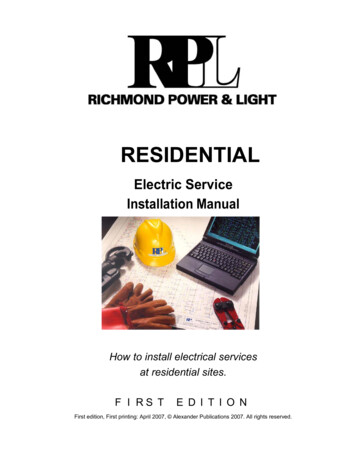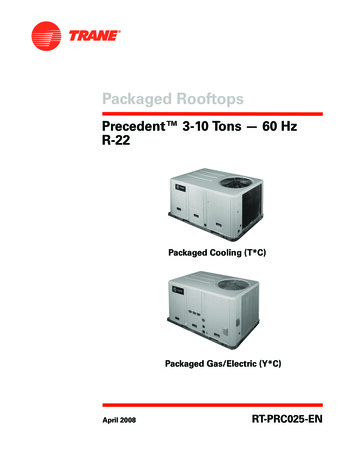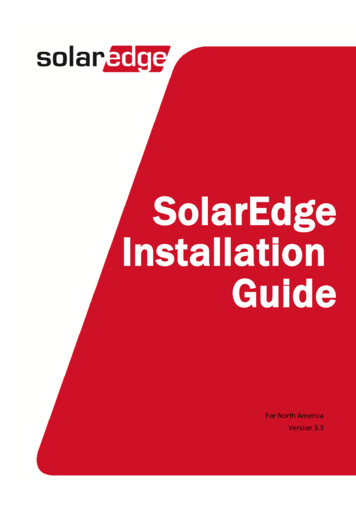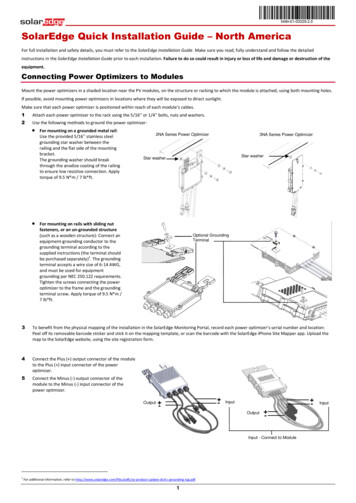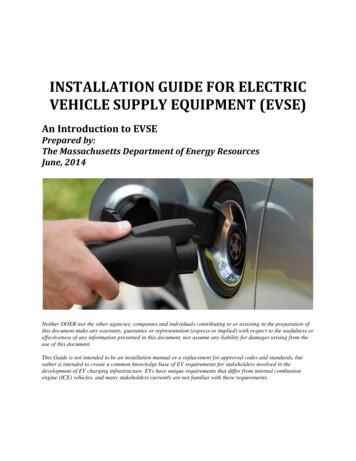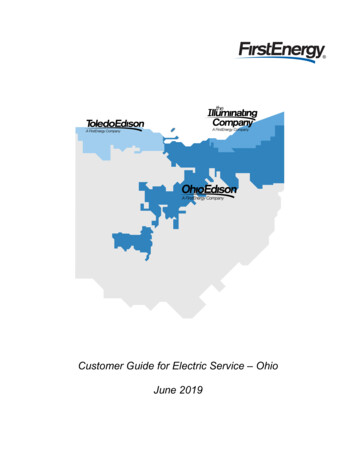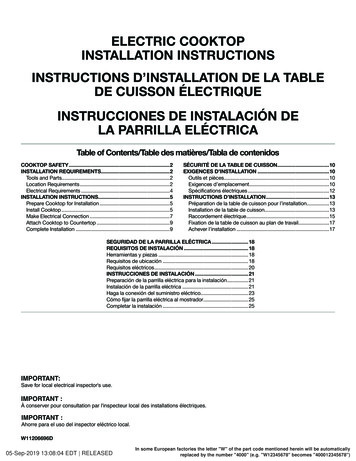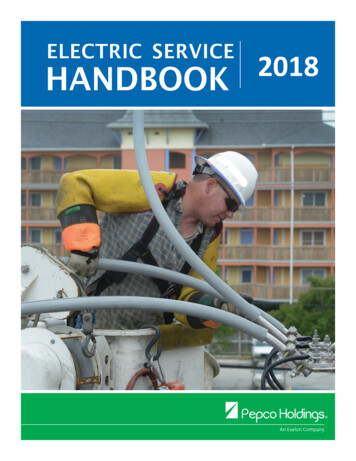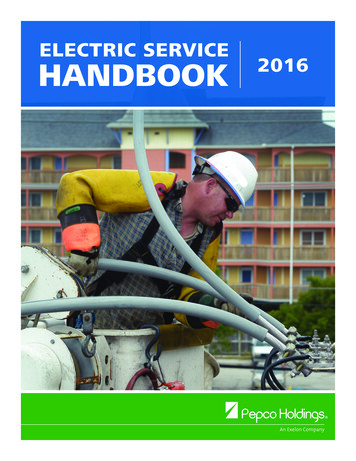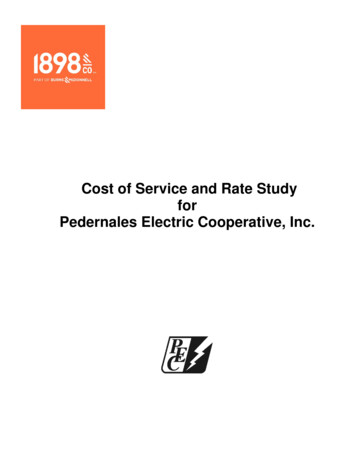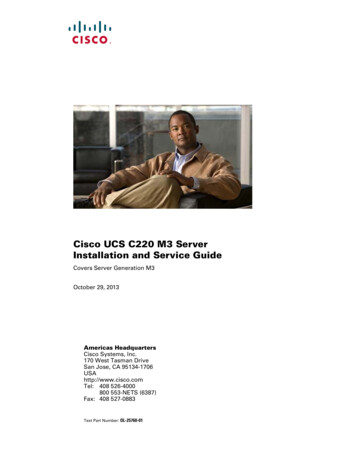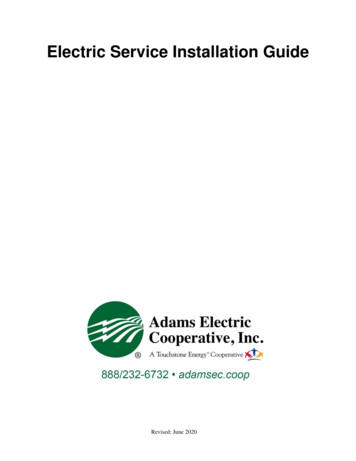
Transcription
Electric Service Installation GuideRevised: June 2020
ADAMS ELECTRIC COOPERATIVEELECTRIC SERVICE INSTALATION GUIDEINTRODUCTIONAdams Electric Cooperative, Inc. (“Cooperative”) provides this guide for all who are performing orplanning electrical installations in the Cooperative service area.This guide does not supersede the National Electrical Code or any applicable federal, state, municipal, orcounty laws or ordinances that are presently in effect, or which may arise in the future.The requirements of this guide are not complete specifications. They merely cover electrical informationand data of mutual concern to the Cooperative and to those performing the electrical work. Thisinformation and data helps to facilitate a proper, reliable, and safe supply of electric service.Compliance with this guide does not absolve the member or the installer from the obligations of installingand maintaining wiring and equipment in a safe condition. Further, the Cooperative does not accept in anyway the responsibility for installation or condition of the member's wiring and equipment. The NationalElectrical Code requirements must be met, and an inspection card from an authorized inspection agencythat is both approved by the Cooperative and licensed in Pennsylvania, must be presented to and acceptedby the Cooperative before service will be connected.The Cooperative may, in its sole judgment and discretion, also require an electric service agreement withterms and conditions as to be specified by and acceptable to the Cooperative. Further, all who will becomemembers of the Cooperative must provide a membership application and agreement, must comply withand be bound by the By-laws of the Cooperative and, as defined therein, all other Governing Documentsof the Cooperative, and must comply with all other applicable policies of the Cooperative.The information in this guide will be revised and/or updated from time to time. To help you keep abreastof these changes, such superseding revisions and/or updates will be posted on the Cooperative’s web site,http://www.adamsec.coop.Our goal is to provide adequate, safe and reliable electric service to all of our member-owners. Shouldyou or your installer need any assistance, further explanation, or have questions concerning this guide orcompliance with any of the requirements of the Cooperative, please contact an office of the Cooperativeand we will be pleased to coordinate with you.Revised: June 20201
TABLE OF CONTENTSI.II.General Information/Application for Service . 3Electrical Inspection. 3III.Right to Refuse Service . 4IV.Types of Service Available . 4V.Meter Locations . 5VI.Construction Service . 5VII.Temporary Service . 5VIII.Pole Mounted Service . 5IX.Three Phase Service . 6X.Seasonal Service . 6XI.Metering . 7XII.A.Single Phase. 7B.Three Phase . 7C.Power Factor. 8Underground . 9A.Single Phase. 9B.Three Phase . 9C.Subdivisions . 10D.Padmounted Clearances . 11F.Natural Gas and Propane Clearance . 11XIII.Motors . 11XIV.Pole Attachments . 12XV.Standby Generation Equipment . 12XVI.Parallel Generation . 12XVII.Mobile Home Service. 12XVIII.Major Load Additions. . 12A.Water Heaters, Plug-In Vehicles, etc . 12B.Heat Pump/Central Air Conditioning . 13C.Welders . 13XIX.Short Circuit Current . 13XX.Multiple Occupancy Buildings . 13XXI.Multiple Services on One Property . 13XXII.Interruptible Loads . 13XXIII.Lighting. 14Approved Meter Base Information. . Appendix ATypical Installation Drawings. . Appendix BRevised: June 20202
I.GENERAL INFORMATIONAPPLICATION FOR SERVICEA.New Construction - The Cooperative's Member Service number (1-800-726-2324) must becontacted before any wiring on the premises is performed so that main panels can be located in away as to be compatible with the meter location. It is recommended that the Cooperative be notifieda minimum of 60 days before service will be required. In cases where three-phase service isrequired, it is recommended that the Cooperative be notified 90 days or more in advance.Within a few days of the receipt of a request for service, a representative of the Cooperative willarrange to meet with the new member and/or his contractor at the construction site. At that meetingmany of the details for service can be worked out including the selection of a meter location. Thecooperative is responsible to determine the meter location, which is typically a location nearest tothe Cooperative’s facilities. Alternative meter locations can be accepted however additional chargesmay be incurred by the member. In order to receive electric service, it will be necessary for the newmember to complete a membership application and pay the current membership fee. In addition,the service connection fee will be assessed in cases where a new service drop is required. Additionalcharges may be levied depending on the length of the line extension required to serve the newmember. The new member will also be required to provide the Cooperative with an easement tocover the new facilities that will be installed on the member's property.The Cooperative is complying with Act 45 of 1999 as adopted by the Commonwealth ofPennsylvania. Act 45 of 1999 dictates that all new construction complies with minimumconstruction and insulation standards. A member must provide a certificate of compliance with Act45 of 1999 and its subsequent amendments in order to establish electric service.B.II.Alterations to Service or Additions to Electrical Load - If alterations to the service entrance areplanned, please notify the Cooperative at 1-800-726-2324 prior to the start of the work. Mostalterations will require an electrical inspection. Where alterations or repairs to the electric servicerequire the meter to be pulled, the electrician doing the work shall contact the cooperative to pullthe meter. Any electrician that cuts the seal of the cooperative shall be charged the then currentmeter tampering fee.ELECTRICAL INSPECTIONOnly electrical inspections issued by approved inspection agencies and accepted or appointed by the localmunicipality will be considered valid. Electrical inspections shall be required in the followingcircumstances:A.B.C.D.E.F.G.Prior to the connection of a new electrical service.Where meter pole disconnects that have been relocated from another location.If an existing main breaker, meter base, entrance cable, or service panel is replaced or relocated.If a property has been affected by a fire or by a flood where the electrical panel has been reached byhigh water.If the service has been disconnected for more than 12 months.If a member has been involved in diversion of power.If a member installs a double pole, double throw switch to serve a generator. Socket mountedswitches for generators do not require the inspection.Revised: June 20203
III.RIGHT TO REFUSE SERVICEThe Cooperative reserves the right to refuse service for the following reasons:IV.A.If three phase service is requested but in the opinion of the Cooperative, the electrical load is notsufficient to justify three phase service (see three phase service).B.If member's wiring is in a condition considered unsafe by the Cooperative, the Cooperative willrefuse connection pending an inspection of the premises by an electrical inspector. This inspectionwill be performed at the member's expense.C.If present standards and policies are not met for line extensions to any account.D.If the member’s service entrance has been installed improperly or at the wrong location.E.If fees and charges have not been paid in full by the new member.TYPES OF SERVICE AVAILABLEThe type of electrical service available depends upon the electrical characteristics, location, and electricalload. Therefore, before any work is performed on the member's property, the Cooperative should becontacted for consultation.When operation of the customer's electrical equipment has the tendency to create an unbalance of theCooperative facilities, every effort must be made by the person installing the equipment to have theelectrical load balanced. The Cooperative will provide whatever information it can to aid in this effort.The following electrical service is 24034277/480*34120/208347200/12470***Members desiring service at 480V will be required to have loads exceeding 50 KW of demand beforeservice at that voltage will be considered.**Members desiring high voltage service must provide their own transformers and other high voltagefacilities including fusing and an approved three phase gang operated switch.Revised: June 20204
V.METER LOCATIONSThe meter location will be designated by the Cooperative. In order to avoid confusion, the Cooperativemust be consulted about this before any electrical work is started. In general, all meter locations will beoutdoors at a location easily accessible to Cooperative personnel and close to the Cooperative'stransformer location. If a member installs their service entrance at a location other than that designatedby the cooperative, the member will be subject to additional charges.For service locations within a flood plain, the cooperative requires meters and disconnects to be installedabove the 100 year flood plain level. In addition, the member must provide safe access to the cooperativeemployees to get to the meter.Where members create obstructions to existing meter locations, they are required to relocate the meter attheir expense including reimbursing the cooperative for any costs it incurs.VI.CONSTRUCTION SERVICEA construction service is a service that will be installed for a short period of time to allow for theconstruction of a new building and that will be replaced by a permanent service. The installation of theconstruction service (structure, disconnect, meter base, etc.) is the responsibility of the member (or thecontractor). The service structure should be located only after meeting with an authorized representativeof the Cooperative, so that the structure can be located close to the permanent facilities. See Sketch #1for details of the overhead construction service structure. If a member elects to install the constructionservice on a pole, that pole must meet the minimum requirements under pole mounted services. (SeeSketch #2). Charges for construction service will be determined by the Cooperative.If a member requests overhead construction service but wants the permanent service to be underground,the member will be subject to an extra charge to cover the extra costs incurred.VII.TEMPORARY SERVICEA service that is expected to be active for a period of less than five years will be considered a temporaryservice. This type of service is one that will be removed when the temporary project is completed andwill not be replaced by a permanent service. These types of installations are generally requested at bridgeand highway or building construction projects to provide electric service to the field office trailer and/orconstruction site. The contractor or other responsible party will be charged for all costs to install andremove the Cooperative's electrical equipment.VIII.POLE MOUNTED SERVICESWhen it is desirable to locate a service on a pole, it shall be a member-owned pole. This pole can besupplied and installed by the Cooperative with the member reimbursing the Cooperative for its costs.Upon approval, a member may provide and set their own pole provided it meets the minimumrequirements of 30 foot, Class 6, pressure treated and is set to a minimum depth of five feet. If a memberelects to supply their own pole for this purpose, it must be free of rot and able to support a lineman. TheCooperative reserves the right to refuse any pole that does not meet these requirements. Service entrancecable or conduit shall be extended to within 18 inches of the top of the pole. See Sketch #2. At no timewill the Cooperative allow an electric service pole to be used by a member to support their television orother antenna.Revised: June 20205
IX.THREE PHASE SERVICEThree-phase service is normally used by industrial and commercial business where single-phase serviceis no longer adequate to meet the member's needs. Three-phase service will be granted to a member if, inthe opinion of the Cooperative, the three-phase service is justified (this normally means loads of 10 HPor larger).If a line extension is required to service a member with three phase service, the Cooperative will performa financial analysis based on a 60 month time frame. If the Cooperative determines the revenue creditwill not offset the cost of the line extension, the member shall pay the Cooperative for 50% of theextension cost in advance and sign a contract with the Cooperative guaranteeing the other 50% throughmonthly minimum wires revenue per month for a 60-month period. This minimum wires revenue isdetermined by the estimated cost of construction. If a three phase load is so large that it affects thesubstation facilities of the cooperative, costs for substation and line improvements will be added to thecharges for service.Three-phase service can be supplied to members in rural areas requesting 120/240 three phase, 4 wireservice by extending only two-phase wires forming an open delta configuration. This type of service willnot be supplied to members whose demand is expected to exceed 50 KW. In cases where the open deltaconfiguration is used, there is an inherent unbalance characteristic that is unavoidable and will causemotors to run hotter than normal. For this reason, it is recommended that motor sizes be increased wherethe open delta configuration is used.Three-phase service at 277/480V three-phase, four wire, will be granted only to those members whosedemand is expected to exceed 50KW. Three phase service at 7200/12470V three-phase, four wire isavailable to those members whose demand is expected to exceed 50 KW who elect to own their owntransformers, primary conductor and other high voltage facilities. At the point of contact, the membermust provide an approved three-phase gang operated switch and fusing protection acceptable to theCooperative.For three phase services where the transformer requirements exceed 1,000 KVA, members will berequired to take high voltage service and own, operate and maintain their own transformers. In addition,members taking high voltage service will have to supply and install an approved three phase gang operatedswitch acceptable to the cooperative and fusing as specified by the cooperative before their transformerfacilities.X.SEASONAL SERVICEService to an account shall be considered seasonal if an account is a cottage, hunting camp, or other parttime occupancy that is not the permanent residence of the consumer-member, including garages,workshops and other small business applications expected to use less than 6,000 kWh per year. Serviceto seasonal accounts is extended under a special set of rules. The cooperative will install a transformerand up to 100 feet of secondary to serve a new seasonal account without charge. For longer services orwhere a primary extension is required, the member will be required to pay 100% of the cost in advance.The cooperative will retain 35% of the payment and the member will be eligible for refund of some portionof the other 65% over a five year period as wires revenue is received from usage by the member. In nocase will the 35% share be refunded and after the first five years has passed, no further refund will begranted.Revised: June 20206
XI.METERINGAny member who requests service greater than 200 ampere self-contained shall submit to the cooperativea Load Data Sheet. That form can be found at the end of this document.A.Single PhaseMost single phase service for members is supplied at 120/240 volt. The following informationapplies to that voltage. Most service is supplied to consumers with a 100, 200 or 400 ampere serviceentrance. These services are metered with a self contained meter. Members with this type of servicesupply their own meter base with the meter being supplied by the Cooperative. It should be notedthat only Class 200 or Class 320 rated meter bases are approved for use with self-containedunderground services. Underground bases with lower rating have insufficient room for propertermination of conductor. Only meter bases approved by the Cooperative are to be used for newinstallations. Approved meter base information can be found in Appendix A, Approved MeterService Devices. If there is any question as to the acceptability of a meter base, please contact theCooperative's member service number, 1-800-726-2324.If the load current per conductor is expected to exceed 200 amps, an evaluation of the meteringneeds will be made by the cooperative. If a 400 ampere service is being requested, normally a class320 meter base will be specified and the appropriate meter used. For installations where over 400amperes of load are expected, current transformer metering will be used. If current transformermetering is used, an arrangement of metering will be designed by the Cooperative to best fit thesituation with the Cooperative supplying the meter base and C.T.'s. Normally rack-mounted C.T.'sare used if the service is overhead. The meter base and rack that holds the C.T.'s are supplied by theCooperative and installed by the member. The one-inch metering conduit shall be schedule 40 PVCor rigid steel and is to be supplied and installed by the member. Refer to Sketch #7 for details.If underground service is requested and C.T. metering is employed, a C.T. cabinet measuring aminimum of 36" x 36" x 10" or 48” X 48” X 10” will be supplied and installed by the member. Thelarger cabinet will be required where a three finger mounting bridge is required. The construction ofthe C.T. cabinet will include double hinged doors and a latching device that will accommodate a1/4" diameter seal and shall be made of a minimum of 16 gauge galvanized steel or 16 gaugestainless steel. If the cabinet is to be located outdoors, it must be of a weatherproof design. If thecabinet is to be located indoors, the location must be approved by the Cooperative. A bracket onwhich the C.T.'s are mounted will be supplied by the Cooperative and must be mounted inside ofthe C.T. cabinet by the member before the C.T. cabinet is mounted in its permanent position. Threequarter inch or greater treated plywood backing inside the C.T. cabinet is required. The meter basefor this type of installation is supplied by the Cooperative and mounted by the member. The oneinch conduit connecting the meter base to the metering cabinet shall be schedule 40 PVC or rigidsteel and is to be supplied and installed by the member. Refer to Sketch #8.It should be noted that more and more members are asking for services in excess of 200 amps eventhough their present loads are considerably below 200 amps. The Cooperative reserves the right todetermine the method of metering for all metering installations based on actual load.B.Three PhaseService is often supplied to members with three-phase service through either a self-contained Class200 or 320 meter socket. Members with this type of service supply their own meter base with theCooperative supplying the meter. It should be noted that only Class 200 and 320 rated meter basesare approved for use with self-contained underground services. Bases with lower rating haveRevised: June 20207
insufficient room for proper termination of conductor. Only meter bases approved by theCooperative may be used. Approved meter base information can be found in Appendix A, ApprovedMeter Service Devices, located at the back of this Installation Guide. A member can verify theacceptability of a meter base by contacting the Cooperative’s member service number 1-800-7262324.If the load per phase is expected to approach or exceed 400 amps, secondary metering will be usedwith the arrangement of facilities to be designed to fit the situation. Normally, rack-mounted C.T.'sare used if the service is overhead. The meter base and the rack that holds the C.T.'s are suppliedby the Cooperative and installed by the member. The one inch metering conduit shall be schedule40 PVC or rigid steel and is to be supplied and installed by the member. Refer to Sketch #9 fordetails.If underground service is requested and C.T. metering is employed, a C.T. cabinet measuring aminimum of 48" x 48" x 10" or 60” X 60” X 10” will be supplied and installed by the member. Thelarger cabinet will be required where a five finger mounting bridge is required. The construction ofthe C.T. cabinet will include double hinged doors and a latching device that will accommodate a1/4" diameter seal and shall be made of a minimum of 16 gauge galvanized steel or 16 gaugestainless steel. If the cabinet is to be installed outdoors, it must be of a weatherproof design. If thecabinet is to be located indoors, the location must be approved by the Cooperative. A bracket onwhich the C.T.'s are mounted will be supplied by the Cooperative and must be mounted inside ofthe C.T. cabinet by the member along with a three quarter inch or greater treated plywood backingbefore the C.T. cabinet is mounted in its permanent position. The meter base for this type ofinstallation is supplied by the Cooperative and mounted by the member. The one inch conduitconnecting the meter base and the metering cabinet shall be schedule 40 PVC or rigid steel and is tobe supplied and installed by the member. Refer to Sketch #8. CT metering in a CT cabinet is limitedto services below 1,200 amps. All underground conduits coming into a CT cabinet shall be providedand installed by the member. Rigid steel conduit is recommended to provide adequate strength forpulling wire. Normally, the elbows are 36 inch radius steel elbows below a cabinet and the straightconduit into the CT cabinet should also be steel. For services requiring a riser pole, refer to Sketch#17 for conduit attachment details. The conduit stub-up at the riser pole shall be installed after thepole has been set in place by Adams Electric, refer to Sketch #17.For members who install larger services above 1,200 amperes, switchgear metering may be specifiedby the cooperative. If metering attached to the switchgear is required, a separate metering cubicleshall be used along with a wire pulling section. The cooperative will provide details of itsrequirements upon request.For members requesting high voltage service, electric service is provided only from overheadfacilities. Metering is provided on a pole installed by the cooperative ahead of the member ownedapproved gang operated switch and fusing arrangement. The cooperative will install and assemblethe metering facilities.C.Power FactorAll three phase accounts are subject to power factor metering. Accounts of this nature are subjectto a power factor penalty if their power factor falls below 90% for a given month. All accountswhose demand exceeds 50 KW with significant motor load should seriously consider the installationof power factor correcting capacitors. Units that switch with the motor are recommended. Thecooperative reserves the right to require, as a condition of service, higher power factors than 90%.Normally, new three phase services are expected to maintain 95% power factor or greater. Thecooperative further reserves the right to limit a leading power factor.Revised: June 20208
XII.UNDERGROUNDThe Cooperative's distribution system is generally overhead and the normal method of supply is byoverhead wires. If a member requests underground service, they will be required to reimburse theCooperative for the estimated extra cost of providing that underground service.A.Single PhaseUnderground service is often supplied by use of an underground service lateral from an overheadtransformer. In this case, the service conductor is supplied and installed by the Cooperative withthe member reimbursing the Cooperative for any extra cost of the conductor when an alternate meterlocation is approved.Underground service is sometimes provided by use of a padmounted transformer. In many cases,this type of service is supplied in developments. The Cooperative supplies and installs theunderground primary, padmounted transformers and foundations. The extra cost for the servicelateral is to be borne by the individual member when an alternate meter location is approved.Underground service from a padmounted transformer can also be furnished to individual members,outside of developments, with the member paying the extra costs associated with providing theservice underground instead of overhead.When underground service is requested by a member or developer, the trenching work, conduit, andconduit installation are the responsibility of the member or developer including cover material andbackfill. This includes the excavation required for the box pad foundations used to support thetransformers. The trench required for primary is to be 38 to 40 inches deep. The trench requiredfor secondary is to be a minimum of 24 inches deep. All trenches shall be free of rocks and debrisat the time of cable installation. If a trench has caved in, it will have to be re-excavated beforeinstallati
planning electrical installations in the Cooperative service area. This guide does not supersede the National Electrical Code or any applicable federal, state, municipal, or county laws or ordinances that are presently in effect, or which may arise in the future. The requirements of thi
